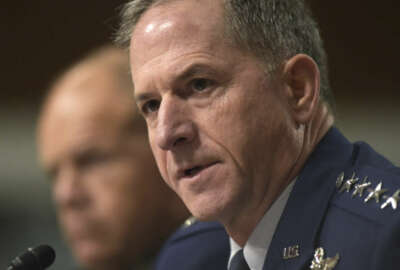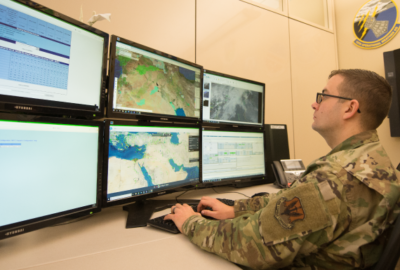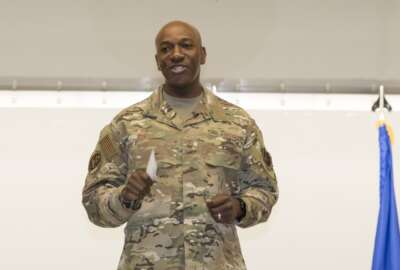 First Look
First Look A look into the Air Force’s weather satellite program
The Air Force is rushing to prepare a new generation of weather satellites. It recently decommissioned one of five existing satellites under the Defense Meterol...
Best listening experience is on Chrome, Firefox or Safari. Subscribe to Federal Drive’s daily audio interviews on Apple Podcasts or PodcastOne.
The Air Force is rushing to prepare a new generation of weather satellites. It recently decommissioned one of five existing satellites under the Defense Meterological Satellite Program. The remaining four are operating years longer than they were designed to. For a progress report Federal Drive with Tom Temin turned to Ball Aerospace program manager Allison Barto and Low earth orbit division chief Charlotte Gerhart of the Space Force Space and Missile Systems Center.
Interview transcript:
Tom Temin: Let’s start with what’s going on now. These satellites that are up there, the DMSP, who do they belong to and what do they do? Let’s start there.
Charlotte Gerhart: Thanks Tom. This is Charlotte and I’ll speak to the DMSP satellites. As you said there are four operational satellites, they belong to the US Space Force. These satellites measure, among other things, ocean surface wind speed and direction. And that’s what the follow on satellite WSFM, Weather System Follow-on Microwave, will address. There is no specific timeline for the end of life of those DMSP satellites. As we’ve done with the prior satellites, we will let them operate as long as they are alive.
Tom Temin: So as long as they’re sending data, you’ll say, okay we’ll take it.
Charlotte Gerhart: That is correct.
Tom Temin: And this data is used primarily for Air Force operations or also other armed services, or what is the data ultimately put in service for?
Charlotte Gerhart: The data is used by all services of the armed forces. It’s also made available to NOAA and NASA and international partners so that it can be used in weather models around the globe.
Tom Temin: And you say there’s no particular timeline that you’ll use the current satellites as long as possible, but they do sometimes die, and you did decommission one. So what happens if, if you’re down to four, and what happens if you got down to three? At some point you’ve got to launch here though, correct?
Charlotte Gerhart: So that’s the intent. That’s why we have procured follow on satellites, WSFM. And the intent is to launch those as soon as we can so that we can continue to have that operational capability.
Tom Temin: And Allison, that is what your company is concerned with is constructing those.
Allison Barto: Absolutely. We’ve been working on to design for the next generation of these satellites since 2018.
Tom Temin: And I imagine they’re more than just simple replacements because of the technology advancing and imaging and sensing and bandwidth and so on. Give us a sense of when the new ones eventually replace the existing ones., what might be added to the capabilities?
Allison Barto: Absolutely. Were working primarily on addressing the ocean surface factor winds, as well as ice concentrations, a number of other critical weather parameters with these new satellites. The satellite that we’re building now, WSFM, it’s primary every instrument is really a next generation of a microwave instrument that we previously built for NASA called GMI. This new satellite adds digital channels into the instrument to allow us to get those wind directions.
Tom Temin: Got it. That really leads to a question I’ve had. I’ve recently talked to NASA and also to the National Oceanic and Atmospheric Administration, all of whom have satellite programs going for various looks at different aspects of the earth, besides what they look out into space with, but just looking at the earth and so forth. Is there generally coordination among all of these agencies that are looking at wind and weather and ice and all of these factors, such that there’s maybe less redundancy and you can complement one another more? Charlotte?
Charlotte Gerhart: Yep, that’s an excellent question. The answer is absolutely. We coordinate very closely with all of the agency so that our systems don’t repeat, are not redundant, but they are complementary.
Tom Temin: What’s the grand challenge in building a new satellite? What does it take such that you don’t simply replicate the old one? I’ve always wondered why when the B-52s die, we’ll just build more of those — well that’s been explained to me why it’s not practical. But in satellites, it’s always moving, isn’t it?
Charlotte Gerhart: That’s true. It is always moving. The challenge is to keep up with the technology as it continues to change. So technology that went into the GMI sensor that Allison referred to, is no longer available. We have the next generation of technology and making sure that that technology works and that we take full advantage of it to get increased capability is probably one of the biggest challenges. Allison, do you have anything to add?
Allison Barto: I think you’ve said it well. We always want to make sure when we’re building something for space that we balance the combination of using heritage designs and processes that have already been proven, and pushing the envelope forward just enough to take advantage of the technological advances that have become possible as time goes on.
Tom Temin: And if some of these technologies of the image gathering and measurement and so forth, can work in space or on earth, but there are special challenges that have to harden them I guess because you can’t go up and solder in some new transistor or something — I’m dating myself — once they’re launched. So what are the special challenges and special technologies that are required for satellite deployment of technology that might have dual use on on the earth?
Allison Barto: I think that you addressed it well, right. We need to make sure that any hardware that we’re putting into space is able to withstand the environment that it sees there, which is more harsh than what we experienced on the ground. So we need to make sure both the hardwares been proven to be able to work in that environment, and then also, as you mentioned, we can’t go fix things. So we need to make sure that anything we put into space has been thoroughly tested and verified prior to launch so that we’re sure that it’s going to be able to both work when it gets on orbit as well as last through and beyond its design life.
Tom Temin: And finally, how will these get into orbit? What’s the mechanism there?
Charlotte Gerhart: These will be launched on rockets that are procured by the US Space Force out of the Space and Missile System Center. The satellite weighs about 1200 kilograms. It goes into an orbit that’s 130 kilometers in altitude, and it will be launched from Vandenberg. We have not identified the specific launch vehicle yet, its selection is due in about a year.
Tom Temin: So 1200 kilograms that’s bigger than a breadbox, isn’t it?
Charlotte Gerhart: It’s two meters tall. So about seven feet tall, and about a meter in diameter. And Allison, you can correct me if I have my dimensions off.
Allison Barto: Yeah, it’s a little bit bigger than that. So the primary dish that collects the signal is 1.8 meters in diameter. And in order to fit well into a variety of launch vehicle options, that dish is stowed for launch so that we have as compact of a satellite as possible in the launch vehicle. And then we deploy this large dish on a set of booms up into position so that we can receive the signals and bounce those signals into our electronics to then process them into the data that we need. So it’s fairly large, as I said before, that this was based on the heritage NASA instrument, GMI. This instrument is about 40% bigger than the previous one. So it’s not insignificant when you look at the full stack of the spacecraft plus the deployed instrument.
Tom Temin: (Jokingly) And before they launched, you took a picture of a family member in there or sign the inside of a sheet of aluminum or something.
Allison Barto: We do not. We don’t want to cause any space debris.
Tom Temin: Got it. And then they would know who did it if it happened later on, right?
Allison Barto: Right. Just just our own memories that we were involved and had our fingerprints on it.
Tom Temin: Alight. Allison Barto is a program manager at Ball Aerospace. Thanks for joining me.
Allison Barto: Absolutely. Thank you.
Tom Temin: And Charlotte Gerhart is Low Earth Orbit Division Chief at the Space Force Space and Missile System Center. Ms. Gerhart. Thanks for joining me.
Charlotte Gerhart: Thank you, Tom.
Copyright © 2024 Federal News Network. All rights reserved. This website is not intended for users located within the European Economic Area.
Tom Temin is host of the Federal Drive and has been providing insight on federal technology and management issues for more than 30 years.
Follow @tteminWFED





